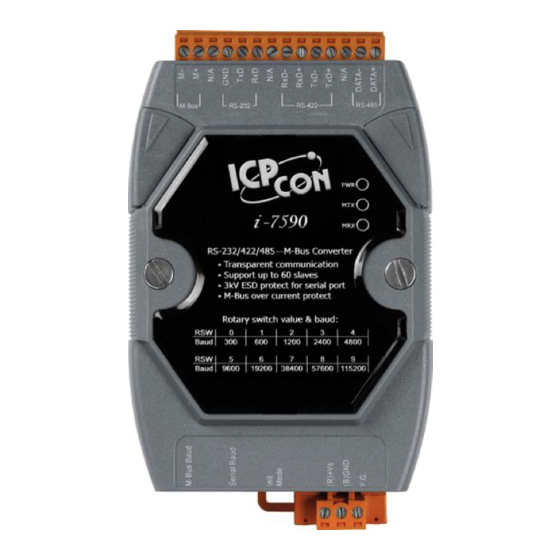
Table of Contents
Advertisement
Quick Links
I-7590 Quick Start
RS-232/422/485 to M-Bus Convertor
1. Hardware Structure
2. Specifications & Features
M-Bus Port: 1
Serial Port: 1 (RS-232 / RS-422 / RS-485)
Serial Baud and M-Bus Baud can be configured separately.
Provides 10 kinds of Baud for default, 6 kinds of Baud for user-defined.
Supports up to 100 M-Bus slaves.
Provides transparent communication.
Watchdog inside.
Allows updating firmware by the RS-232 port.
Overcurrent and short-circuit protection on the M-Bus port.
3750 Vrms photocouple isolation on the M-Bus port.
±4 kV ESD to contact.
Reverse polarity protection on power.
Provide 3 LED indicators, PWR LED, MTX LED and MRX LED.
Power requirement +10 V
Power consumption 1.8 W @ 24 V
Operating Temperature: -25℃ ~ +75℃.
Storage Temperature: -30℃ ~ +80℃.
Humidity: 10 to 90% RH, Non-condensing.
Dimensions: 72mm x 122mm x 33mm (W x L x H).
I-7590 Quick Start v1.00, July 29, 2014 -------------------------------------
~ +30 V
.
DC
DC
(with 1 slave device).
DC
10 W @ 24 V
(with 100 slave devices).
DC
1
Advertisement
Table of Contents

Subscribe to Our Youtube Channel
Summary of Contents for ICP CON I-7590
- Page 1 (with 100 slave devices). Operating Temperature: -25℃ ~ +75℃. Storage Temperature: -30℃ ~ +80℃. Humidity: 10 to 90% RH, Non-condensing. Dimensions: 72mm x 122mm x 33mm (W x L x H). I-7590 Quick Start v1.00, July 29, 2014 -------------------------------------...
- Page 2 350m; this length corresponds to a cable resistance of up 29Ω. This distance applies for the standard configuration having Baud rates between 300 and 9600 Baud, and a maximum of 250 slaves (I-7590 supports max 100 slaves). The maximum distance can be increased by limiting the Baud rate and using fewer slaves.
- Page 3 I-7590 must be disabled. Users can open the cover of the I-7590, and adjust the SW2 for RS-485 (or SW2 and SW3 for RS-422) to configure the bias resistor. It would be as the following figure.
- Page 4 Update firmware mode 5. Rotary Switch The I-7590 has two rotary switches for the configuration of the M-Bus Baud rate and serial port Baud rate. The following table describes the mapping table between the rotary switches and Baud rate. After changing the configuration of the rotary switches, the I-7590 needs to reboot to enable the new setting.
- Page 5 Step 1: Connect the PC COM port to the RS-232 port of the I-7590. Set the DIP switch to the configuration mode (refer to the section 6) and then power it on. Step 2: Execute the I-7590 utility, and select the correct port number and the Baud rate.
- Page 6 Step 3: Afterwards, the I-7590 utility shows all settings stored in the I-7590 if it had been configured before, or shows “User Defined” if there is no configuration. If users want to clear the setting before, click the “Clr” button behind the item to clear the corresponding configuration.
- Page 7 COM ports, for example SUDT AccessPort as the following website http://www.sudt.com/en/ap/. Send a standard M-Bus command from the PC through RS-232, and I-7590 will pass the command to the M-Bus network and the M-Bus meter will reply the command to the PC.
- Page 8 Users can set the DIP switch to Update Firmware mode (refer to the section 6) and reboot the I-7590 for updating the firmware of the I-7590. In this case, the three LED, PWR, MTX, MRX are all always turn on. Users need to connect the PC COM port with the RS-232 port of the I-7590 and use the “FW_Update_Tool”...


Need help?
Do you have a question about the I-7590 and is the answer not in the manual?
Questions and answers